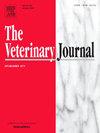Antimicrobial pressure in healthy breeding dogs vs household animals assessed through the resistance profile of Escherichia coli and coagulase positive Staphylococci
IF 3.1
2区 农林科学
Q1 VETERINARY SCIENCES
引用次数: 0
Abstract
Antimicrobials are sometimes inappropriately administered in dog breeding facilities in an attempt to improve fertility or reduce neonatal losses, but these practices lead to an increased prevalence of resistant bacteria. The aim of this study was to assess antibiotic use intensity in breeding kennels by comparing the resistance profiles of Escherichia coli and coagulase positive Staphylococci isolated from breeding bitches and from household animals. A rectal and a perivulvar swab were collected from 80 healthy bitches, half of which were housed in breeding kennels and the other half in domestic environments. The resistance of Escherichia coli, Staphylococcus pseudintermedius and S.aureus to a range of antimicrobials was evaluated through the Minimum Inhibitory Concentration test. Antibiotic resistance rates, the percentage of Extended Spectrum Beta-Lactamase (ESBL)-producing E.coli strains, the percentage of mecA positive methicillin-resistant Staphylococci and of Multi-Drug Resistant (MDR) isolates were compared between breeding bitches and privately owned ones using Fisher's exact test. The percentage of resistance to the antimicrobials tested was generally higher in dogs from breeding kennels than in owned animals, with statistically significant differences in E.coli for cefazolin (p < 0.0001), third-generation cephalosporins (p = 0.0015), tetracycline (p = 0.0079), kanamycin (p = 0.0291) and trimethoprim-sulfamethoxazole (p = 0.0007). Furthermore, the prevalence of ESBL E.coli was significantly higher in breeding dogs (p = 0.0002). 38.5 % of breeding bitches and 12.5 % of household dogs carried methicillin-resistant mecA positive S.pseudintermedius strains. S.aureus was only isolated from household animals, and one of the three isolates was mecA positive and MDR. Our data indicate a higher exposure of kennel dogs to antimicrobials. The pattern of antibiotic resistance, particularly to aminopenicillins but also to amoxicillin-clavulanic acid, suggests a large use of these agents. The results confirm that healthy dogs can harbour commensal bacteria that have acquired antimicrobial resistances, which may be exchanged between hosts; the potential role of the two dog typologies as reservoirs for resistance genes was demonstrated. The risk of household dogs being exposed to resistant bacteria, probably of human origin, was also observed. Our study reveals a generally high exposure of dogs to antimicrobials and highlights the need to sensitise veterinarians and breeders to better antibiotic stewardship.
通过大肠杆菌和凝固酶阳性葡萄球菌的耐药性评估健康育种犬与家养动物的抗微生物压力。
为了提高生育能力或减少新生儿损失,犬种繁殖设施有时会不恰当地使用抗菌素,但这些做法导致耐药细菌的流行率增加。本研究的目的是通过比较从繁殖母狗和家庭动物中分离的大肠杆菌和凝固酶阳性葡萄球菌的耐药谱,评估育种犬舍的抗生素使用强度。对80只健康母狗进行直肠和外阴拭子采集,其中一半饲养在繁殖犬舍,另一半饲养在家庭环境中。通过最小抑菌浓度试验评估了大肠杆菌、假中间葡萄球菌和金黄色葡萄球菌对一系列抗菌素的耐药性。采用Fisher精确检验法比较了繁殖母狗和私人母狗的抗生素耐药率、产广谱β -内酰胺酶(ESBL)大肠杆菌百分比、甲氧西林耐药葡萄球菌百分比和多重耐药(MDR)分离株百分比。饲养的狗对抗菌剂的耐药率普遍高于饲养的狗,头孢唑啉的大肠杆菌有统计学上的显著差异
本文章由计算机程序翻译,如有差异,请以英文原文为准。
求助全文
约1分钟内获得全文
求助全文
来源期刊

Veterinary journal
农林科学-兽医学
CiteScore
4.10
自引率
4.50%
发文量
79
审稿时长
40 days
期刊介绍:
The Veterinary Journal (established 1875) publishes worldwide contributions on all aspects of veterinary science and its related subjects. It provides regular book reviews and a short communications section. The journal regularly commissions topical reviews and commentaries on features of major importance. Research areas include infectious diseases, applied biochemistry, parasitology, endocrinology, microbiology, immunology, pathology, pharmacology, physiology, molecular biology, immunogenetics, surgery, ophthalmology, dermatology and oncology.
 求助内容:
求助内容: 应助结果提醒方式:
应助结果提醒方式:


